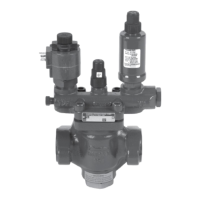SERVICE AND MAINTENANCE
Failure to open: Wrong coil or control module pilot; low
line voltage; controlling switch or thermostat not
contacting; coil is burned -out; adjacent shut-off valve
closed; adapter gasket hole not aligned with hole in
body and adapter; dirt packed under Teflon seal ring
enabling excessive blow by; large quantity of dirt
particles in solenoid module passages; dirt blocking
internal pilot passages; main valve seat is dirt jammed.
Failure to close: Controlling switch or thermostat not
opening contacts; manual- opening stem is turned in;
valve installed in wrong direction; damage or dirt at
main valve seat or pilot seat; piston bleed hole
plugged. Under extreme conditions of liquid or oil
“slugging” or pressure drops exceeding 45 psi (3.1
bar), special construction may be required. Contact the
factory.
Before opening the regulator or disassembling the pilot
for service, be sure it is isolated
from the system and all refrigerant is removed (pumped
out to zero pressure). Follow usual refrigeration system
safe servicing procedures. Read the CAUTION section
of this bulletin on page 20.
To check solenoid pilot section of valve, disconnect the
electrical coil. Unscrew the coil nut and remove
washer. Lift coil housing away from valve. Remove the
four solenoid tube screws and remove solenoid tube
from valve. Inspect for dirt and damage to Teflon seat
and stainless steel pilot orifice. Clean, polish or replace
parts as necessary, then reassemble.
¾" through 1¼" (20 mm through 32 mm): Use a
3
/8"
male hexagon wrench to loosen the four adapter bolts,
proceeding slowly to avoid refrigerant which may still
remain in the valve. If piston parts are stuck, remove
the 2" hex bottom cap in order to separate the valve V-
port/seat from the disc piston. Inspect disc and piston
bore for burrs, nicks, and other damage. Remove burrs
and nicks, clean or replace disc piston and Teflon seal
ring as necessary. Long- life seal on disc piston need
only be replaced when damaged or severely worn. If
replacing the disc piston seal, make sure the seal is
properly installed, with the edge up, and does not
“twist” during installation. Inspect V-port/seat and main
valve seat for nicks, marks, etc. The main valve seat
may be lapped by hand or power drill to remove marks.
Clean, polish or replace parts as necessary. If
necessary, the V-port tapered seat may be
reconditioned by removing up to 0.04" (1 mm) of Teflon
from it on a lathe. Lightly lubricate all parts and gaskets
with soft rag containing refrigerant oil. Align hole in
valve body, adapter gasket, and adapter to assure
proper operation. Reassemble valve. Carefully check
valve for leaks before returning it to service.
1½" through 6" (40 mm through 150 mm):
Loosen adapter bolts using a 12" adjustable wrench
(15" wrench for 5" and 6" valves), being careful to avoid
any refrigerant which may still remain in the valve. If
disc piston is difficult to remove, insert a ¼"-20
threaded screw (
3
/8"-16 for 5"& 6" valves) into center of
piston and lift straight -up. Inspect piston and piston
bore for burrs, nicks and other damage.
Remove burrs and nicks, clean or replace piston as
necessary. Long-life seal on disc piston need only be
replaced when damaged or severely worn. If replacing
the disc piston seal, make sure the seal is properly
installed, with the edge up, and does not “twist” during
installation. These valves also have a removable
stainless steel main valve seat. To remove seat ring for
inspection, first remove small hex head seat screw.
Turn the seat ring counterclockwise by turning it out
with a wrench and a steel bar tool positioned
horizontally or by carefully tapping the seat ring notch
with a punch and a hammer. Inspect the V-port/seat
and main valve seat for nicks, marks, and divots. The
main valve seat may be lapped by hand or power drill
to remove marks. Grease and replace the seat seal O-
ring. Clean and polish, or replace the parts as
necessary. If necessary, the V- port tapered seat may
be reconditioned by removing up to 0.04" (1 mm) of
Teflon from it on a lathe. Lightly lubricate all parts and
gaskets with a soft rag containing refrigerant oil. Align
the hole in the valve body, adapter gasket, and adapter
to assure proper operation. Reassemble the valve.
Carefully check the entire valve for leaks before
restoring it to service.
MANUAL OPENING
The manual-opening stem is designed to open the
valve, allowing upstream and downstream pressures to
equalize when needed for servicing, but not necessarily
to create a full-flow condition. The stem is located on
the top of the adapter cover. Slowly remove the seal
cap from the manual-opening stem, being cautious to
avoid any refrigerant which may have collected under
the cap. Using an appropriate wrench, turn the stem in
(clockwise) to open the valve manually;
counterclockwise to return the valve to automatic
operation. Do not leave the stem partially open because
it may be dynamically damaged.
ABBREVIATIONS
BW: Butt Weld end to match American Pipe
Schedule 40
CRN: Canadian Registration Number
CSA: Canadian Standards Association
Cv: Valve capacity factor GPM (U.S.) of water at 1 psi
differential
FPT: Female Pipe Thread, American National Standard
Kv: Valve capacity factor m
3
/hr of water at 1 bar
differential
mA: milliampere
MPT: Male Pipe Thread, American National Standard
NEMA: National Electrical Manufacturers
Association: Class 4, watertight, approximate
equivalent to IP65; Class 1, general purpose,
approximate equivalent to IP20
NPT: National Pipe Thread
ODS: Outside Diameter Sweat, for copper tubing
PLC: Programmable Logic Controller
psig: Pounds per square inch, gauge
R/S: Refrigerating Specialties Division, Parker
Hannifin Corp.
SPDT: Single Pole Double Throw
SW: Socket Weld to accommodate American and API
pipe WN or Weld: Weld Neck to match American Pipe
Schedule 40

